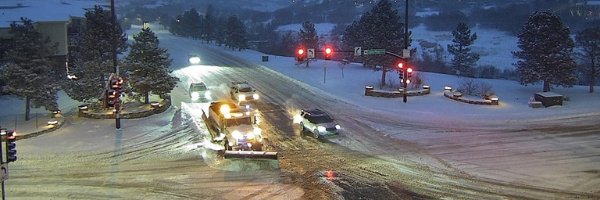Frequently Asked Questions About Snow Removal
What can I expect regarding snow removal prior to, during, and after the storm?
During heavy snowstorms, plows will often clear lanes simultaneously. Multiple snowplows often plow together to remove snow from multi-lane streets. This results in more efficient operation and eliminates piles of snow in the roadway that may become obstructions to vehicles. When you see this process in action, please give equipment adequate room to operate. Do not drive within a snowplow operator’s blind spot as he/she is not able to see you. For personal safety, never pass a snowplow that is engaged in snow removal. Snow and ice that comes off the plow blade can damage your vehicle or greatly obstruct your vision. Passing an operating snowplow in “echelon formation” with two or more snowplows arranged diagonally is now a Class A traffic offense, punishable by a fine of up to $100.
Castle Pines clears all roadways according to priority until conditions are safe for travel. Cul-de-sacs and some local streets may not be plowed if accumulations are minor and snow is expected to melt over the following 24 to 48 hours. Exceptions to this are made if the streets have hills or curves that may become icy and hazardous to traffic.
Depending upon temperatures, wind velocities, and the extent of snowmelt, crews may have to widen travel lanes, remove ice, and perform other operations for several days after a snow event. Snow from adjacent properties can melt and re-freeze overnight, creating ice buildup on the street. To report ice buildup on a street, please complete the Public Works Request form.
Residential streets may not be plowed if parked vehicles or other obstructions interfere with the safe and continuous operation of snow removal equipment. Equipment may return to plow after obstructions are moved. When a snowstorm is forecasted, residents are advised to move vehicles off the street to allow safe access by snowplows.
